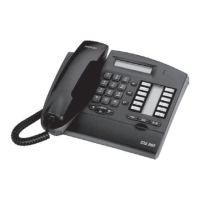CALL METERING SERVICES APPLICATIONS
Ed. 0428/30 Réf. 3EH 21000 BSAA
108/2 (20): Data Terminal Ready (DTR)
The DTE closes this circuit to tell the DCE it is ready to operate.
Incoming call: closing circuit 108/2 authorizes the DCE to take an incoming call. The DTE is advised
accordingly by the closure of circuit 107 to indicate the trunk seizure. The dialog initialization phase
now begins.
Outgoing call: the outgoing call is initialized between the DTE and the DCE by a local dialog exchan-
ged on circuits 103 and 104.
109 (8): Data Carrier Detect (DCD)
Closing this circuit indicates that the carrier signal received on the data channel meets the relevant spe-
cifications.
This circuit can also be used in the closed state for DTE-DCE data exchanges when programming or
controlling serial automatic call DCEs.
125 (22): Ring Indicator (RI)
This circuit is closed to tell the DTE that a call signal has been received by the DCE.
141 (18): Local Loop (LL)
This circuit controls type 3 test loops in the DCE.
The closure of the circuit loops the DCE transmission channel back to the reception channel, on the
data channel side. On detecting that circuit 142 is closed, the DTE can then, in full-duplex mode, test
the DCE transmission interfaces. This looping function is not yet available in the current state of deve-
lopment of the product.
142 (25): Test Indicator (TI)
The closure of circuit 142 indicates that the DCE is in test mode, which precludes any transmission with
a remote DTE.
V24 metering printouts: configuration details
Physical characteristics
- Type of interface: V24
- Operating mode: asynchronous
- Interface function: DCE
Transmission characteristics
- Number of significant characters: 5, 6, 7 or 8 (default value)
- Parity: even, odd, no (default value), marked (set at 1) or spaced (set at 0)
- Number of stop bits: 1 (default value), 1.5 or 2
- Baudrate: 50, 75, 150, 300, 600, 1200, 2400, 4800, 9600 (default value), 14400, 19200
- Rate adaptation: V110 (default value), X31, V120 or V14E (for 57600 bps)

